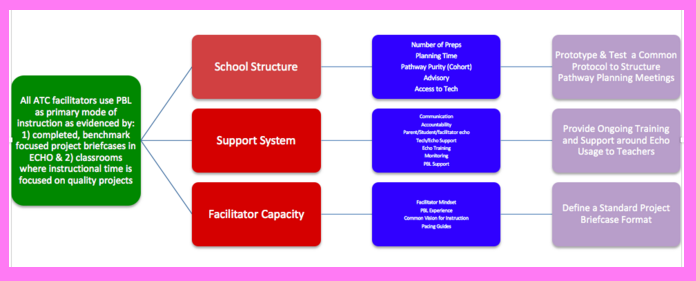
This link will only work if you’re logged into Echo. Sorry, non-New Tech readers. If you have more questions, you can tweet Jim May at @jimamay.

Why have a focus area for change:
- we get better SPECIFICALLY, not GENERALLY
Finding a Focus Criteria:
- related to STUDENT LEARNING
- emerges from multiple sources of data
- politically feasible
- advances school’s mission & purpose
The Framework can be used to classify types of focus areas:

Caveats:
- If focus is not shared enough – don’t know where to look to see if it’s working
- Hope is not a strategy
- Principal can not be the only source of feedback (need to leverage peer feedback)
Guiding Questions
- What are the unique challenges that relate to focus area? Evidence of these?
- What are the unique strengths we already possess relating to focus area? Evidence of these?
- What do possible strategies and outcomes look like?
- How will we observe and measure outcomes related to focus area?
From focus to strategy: Sources:
- experts in the field,
- reading literature,
- disciplined experimentation of new strategies
Strategies (Goor characteristics):
- Can have multiple activities that share one focus area
- Addresses both technical and adaptive elements
- Increases learning of stakeholders related to focus area
Driver diagrams:
- displays primary drivers (red) and related factors (blue) that connect to focus area (green);
- can be used to brainstorm strategies (lavender) that relate to focus areas

Testing and Learning from Strategies:
- Use student work as primary source of evidence
- Analyze student work using specific question(s) related to focus area
- Examine the learning task that led to the student work
- Keep time between analysis and action very short
- Try to link data directly to improving practice
- Use data analysis to develop a deeper shared understanding of focus area
Designing & Interpreting Data Inquiries:
- data related to specific questions tied to focus area
- shared knowledge base that can be used to make analytical decisions about data
- create artifacts that anchor sense making
- impose structure on data to make meaning of it

School change is hard, but vital. Developing and implementing processes for setting, implementing, learning from, and revising school change goals is vital to maintaining and improving the quality of PBL schools. Having a specific focus related to student learning that is backed by data derived from student work helps schools select focus areas that serve their primary clients, the students, and their primary mission, learning.

Preparation Steps
- Brainstorm possible focus areas using criteria above.
- If needed, gather more data related to potential focus areas.
- Analyze school structures that relate to focus area (drivers).
- Research & develop potential strategies for improving and learning more about focus areas.
- Identify evidence that can be used to assess potential strategies.
- Develop a data inventory that describes all the data sources that will be used to investigate focus area, when these will be gathered, how to access these, and ideas for how to interpret these.
Early Implementation Steps
- Implement strategies.
- Use pre-planned evidence gathering strategy, to collect student work that can be interpreted to learn more about focus area.
- Create data summaries that make sense of data and provoke interesting conversations.
- Have regular data meetings focused on making sense and developing key questions from data related to focus area.
Advanced Implementation Steps
- Involve students and alumni in key committees that select focus areas and that interpret and learn from data.
- Use student panels to gain more qualitative data that relates to other data sets collected to investigate focus area.
